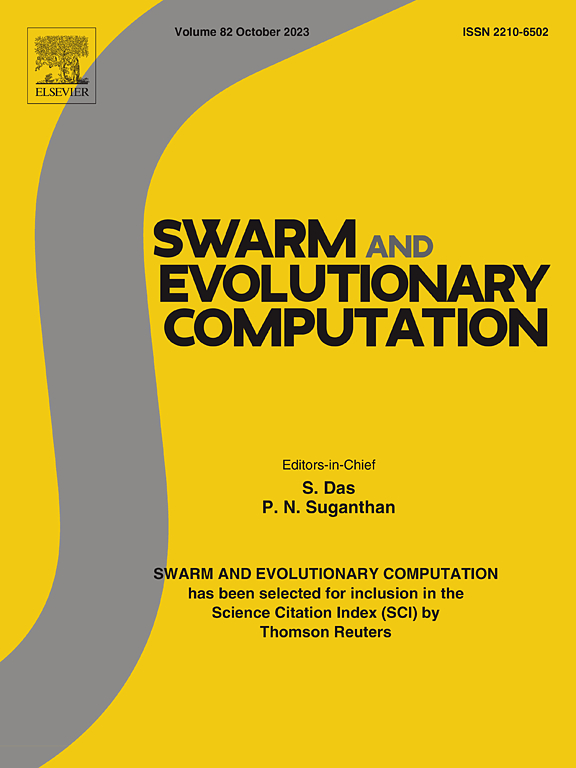在支持物联网的智能表面中使用优化的动态密度图卷积网络增强协作通信
IF 8.2
1区 计算机科学
Q1 COMPUTER SCIENCE, ARTIFICIAL INTELLIGENCE
引用次数: 0
摘要
可重构智能表面(Reconfigurable intelligent surface, RIS)是一种软件控制的无源设备,作为一个中继系统,以最优信号强度的合作模式将接收到的信号从信号源反射到目的地。依赖于物联网的网络的可配置和灵活的RIS允许独立或合作安排,与传统网络相比具有显着优势。尽管具有潜力,但由于相移优化和符号识别的复杂性,在基于物联网(IoT)的网络中有效实施RISs仍然是一个困难。在本文中,提出了在支持物联网的智能表面(ECC-DDGNN-IoT IS)中使用优化的动态密度图卷积网络增强协作通信。它着重于通过动态密度图卷积网络(DDGNN)方法优化RIS相移。这种优化提高了协作通信环境下的信号质量和整体系统性能。该模型解决了目的地最大生计(ML)检测的复杂性。介绍了一种基于ddgnn的符号识别方法,以及ddgnn辅助的RIS相位优化。该技术减少了接收机的计算负荷,同时保持了良好的检测精度。为此,提出人工原生动物优化器(Artificial Protozoa Optimizer, APO)对DDGNN模型的权重参数进行优化,实现RIS的相位精确偏移。该模型在MATLAB平台上实现。与现有的基于深度学习的物联网依赖RIS进行协作通信(DNN-IoT-RISCC)、基于深度学习的可重构智能表面辅助RSM和RSSK检测(BDNN-RIS-RSSK)以及基于大规模物联网网络的半联邦学习进行协作智能(SFL-CI-MIoT)等技术相比,所提出的ECC-DDGNN-IoT-IS方法具有高精度、低RMSE和计算复杂度。本文章由计算机程序翻译,如有差异,请以英文原文为准。
Enhancement of collaborative communication using optimized dynamic density graph convolutional networks in IoT-enabled intelligent surfaces
Reconfigurable intelligent surface (RIS) is defined as a software-controlled passive devices acts as a relay system, reflecting receiving signals from the source to destination in a cooperative mode with optimal signal strength. An IoT-dependent network's configurable and flexible RIS allows for stand alone or cooperative arrangements with significant advantages over traditional networks. Despite its potential, efficient implementation of RISs in Internet-of-Things (IoT)-based networks remains a difficulty because to the complexity associated with phase shift optimisation and symbol identification. In this manuscript, Enhancement of Collaborative Communication using Optimized Dynamic Density Graph Convolutional Networks in IoT-Enabled Intelligent Surfaces (ECC-DDGNN-IoT IS) is proposed. It focuses on optimising the RIS phase shifts through Dynamic Density Graph Convolutional Networks (DDGNN) approaches. This optimisation increases the signal quality and overall system performance in cooperative communication circumstances. This model addresses the complexity of Maximum Livelihood (ML) detection at destination. A DDGNN-based symbol identification method is introduced, along with DDGNN-assisted phase optimisation of the RIS. This technique decreases computational load on the receiver while retaining good detection accuracy. Therefore, Artificial Protozoa Optimizer (APO) is proposed to optimize the weight parameter of DDGNN model to accurately shift the phase of RIS. This model is implemented in MATLAB platform. The proposed ECC-DDGNN-IoT-IS method attains high accuracy, low RMSE and computational complexity compared to the existing techniques, such as deep-learning enabled IoT depend RIS for cooperative communications (DNN-IoT-RISCC), Deep Learning dependent Detection on Reconfigurable intelligent surface Assisted RSM and RSSK (BDNN-RIS-RSSK), and semi-federated learning in massive IoT networks for collaborative intelligence (SFL-CI-MIoT) respectively.
求助全文
通过发布文献求助,成功后即可免费获取论文全文。
去求助
来源期刊

Swarm and Evolutionary Computation
COMPUTER SCIENCE, ARTIFICIAL INTELLIGENCEC-COMPUTER SCIENCE, THEORY & METHODS
CiteScore
16.00
自引率
12.00%
发文量
169
期刊介绍:
Swarm and Evolutionary Computation is a pioneering peer-reviewed journal focused on the latest research and advancements in nature-inspired intelligent computation using swarm and evolutionary algorithms. It covers theoretical, experimental, and practical aspects of these paradigms and their hybrids, promoting interdisciplinary research. The journal prioritizes the publication of high-quality, original articles that push the boundaries of evolutionary computation and swarm intelligence. Additionally, it welcomes survey papers on current topics and novel applications. Topics of interest include but are not limited to: Genetic Algorithms, and Genetic Programming, Evolution Strategies, and Evolutionary Programming, Differential Evolution, Artificial Immune Systems, Particle Swarms, Ant Colony, Bacterial Foraging, Artificial Bees, Fireflies Algorithm, Harmony Search, Artificial Life, Digital Organisms, Estimation of Distribution Algorithms, Stochastic Diffusion Search, Quantum Computing, Nano Computing, Membrane Computing, Human-centric Computing, Hybridization of Algorithms, Memetic Computing, Autonomic Computing, Self-organizing systems, Combinatorial, Discrete, Binary, Constrained, Multi-objective, Multi-modal, Dynamic, and Large-scale Optimization.
 求助内容:
求助内容: 应助结果提醒方式:
应助结果提醒方式:


